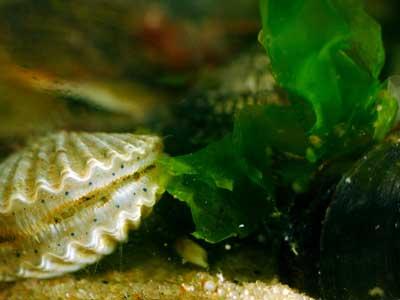Protected Scallop Spawning Oasis Destroyed

With scallop season barely under way, an 8,000-square-foot scallop sanctuary on the east side of Napeague Harbor, one of two shellfish sanctuaries in East Hampton Town waterways, was breached last week. The buoys delineating its perimeter were dragged aside and the bottomland, which had been abundant with mature and juvenile scallops as well as eelgrass, uprooted.
Created in 2009 in what is considered a successful effort to reseed local waters with bug scallops after a precipitous die-off in the mid-1980s attributed to brown tide, the sanctuaries are off limits to commercial and recreational fishing.
John Dunne, director of the town’s shellfish hatchery, which implemented the program with the consent and assistance of the town trustees, discovered that the sanctuary had been vandalized on Friday around 2 p.m. There were “buoys all over the place, people walking around where it had been,” he said of the shallow protected area. The Marine Patrol, he said, had been “making their presence known, and it seemed to me [the perpetrator] probably waited until they left and traipsed right in there.”
Joe Bloecker, a trustee, filed a report with town police on Monday. “I went down there on Saturday to go scalloping,” he said. “I got in the water, made my way down there, and what I saw was pretty disconcerting. There were dredge marks all through there, and there was nothing in there — no bugs, no scallops. I’m very disappointed. It’s such a shame that someone could ruin a whole year’s worth of scalloping in Napeague Harbor.”
Nat Miller and Sean McCaffrey, both trustees, had given the Napeague sanctuary an extra layer of protection. “We went above and beyond — placed a buoy every six feet and roped it up in a circle to keep people out of it,” said Mr. Miller, a bayman. “We’ve had this problem before, in Three Mile Harbor. It’s not the first time, but like everything else, you keep trying to do something, and it just takes one bad apple to mess it up for everyone else.”
Ed Michaels, the town harbormaster, believes the incident took place last Thursday. “We’re trying to find out what guys were in the area,” he said, meaning commercial fishermen, “and see if they saw anything.”
Mr. Michaels cautioned against assuming intentional sabotage. “Those things aren’t marked,” he said of the sanctuaries in Napeague and Three Mile Harbors. “It’s possible it was a mistake. Probably not, but there’s a chance that someone didn’t know what they were looking at.” Anyone fishing in the vicinity should know not to enter a shellfish sanctuary, he said, but, “it’s a double-edged sword: if you mark them, they know what’s in there.”
Those obtaining a shellfish license from the town clerk’s office are given a booklet with the rules governing shellfishing and maps of open and closed shellfishing waters. “Some people, believe it or not, don’t always read the handbook,” said Stephanie Forsberg, a trustee. “These shellfish sanctuaries are marked out on maps. It’s beyond unfortunate that somebody goes into the area.”
Under the shellfish hatchery’s Bay Scallop Restoration Project, funded by the town and grants from the state and the county, scallops are grown and over-wintered at the hatchery, in Montauk. The following spring, low-traffic areas of Napeague Harbor and Three Mile Harbor are seeded with the bugs and cordoned with buoys. (An effort to reintroduce scallops and eelgrass at a third site, Hog Creek in Springs, was unsuccessful and abandoned.)
Scallops are “broadcast” spawners that emit sperm and eggs into the water, and a highly concentrated population is needed for fertilization to result, Mr. Dunne said, hence the creation of protected sanctuaries. Shellfish hatchery officials document spawning and monitor survival from May to November each year.
The sanctuaries have more than doubled the prevalence of spat, the scallop’s “just-after-juvenile” stage, said Ms. Forsberg. “The idea is you have this really dense, concentrated area, and no one can take from it. Once they reproduce, it overflows into the harbor. I love that we’ve been seeing those sort of numbers. That’s why, as trustees, we want to keep supporting the hatchery and their work on this.”
“We do ‘survival’ dives,” Mr. Dunne said of his agency’s monitoring efforts. “We saw that there were lots of bugs in the sanctuary. The problem with people walking through there, stepping on bugs — those bugs are just as, if not more, important than the stuff they took.”
Hatchery officials had also seeded a section of the Napeague Harbor sanctuary with oysters. “It’s just as disappointing that those were kicked around,” he said.
Mr. Dunne and town trustees pointed to last year’s bumper scallop crop as evidence that their efforts have been worthwhile. “It seems to be working, and we’ve been backing it up with spat-collection data,” Mr. Dunne said. “Every year that spat number was going up. We had that stellar harvest last year in Napeague. It seems to be that the only harbors in town with scallops are the ones that have sanctuaries in them.”
Diane McNally, the trustee clerk, said the trustees had received encouraging reports of “scallops traveling outside the sanctuary area, to be harvestable.” Trustees have expressed “a lot of frustration, a lot of anger” about what happened last week, she said, and they are considering offering a reward for information leading to identification of a perpetrator.
Mr. Dunne said he was disappointed but not surprised. “I think it’s been happening, pretty much, every year. I’m disappointed for the people following the rules and respecting the fact that the sanctuaries are providing a service, because it’s pretty well proven that the sanctuary is making a huge difference.” But, he said, “Neither we, nor the baymen following the rules, nor Marine Patrol can be at all places at all times.”
